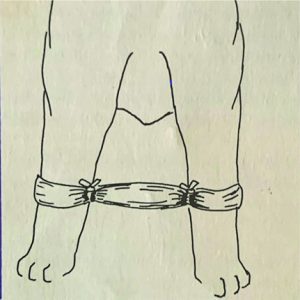This article was added by the user . TheWorldNews is not responsible for the content of the platform.
“SWIMMER” SYNDROME (aka “FLAT PUPPY” AILMENT)
Q: What is this ailment in new-born puppies?
A: As the name suggests, the young pup would be observed to be waddling around on its belly in a swimming motion, instead of standing on its four legs. In other words, the legs are sprawled out sideways as the animal moves forward on a flat surface (as a turtle would in water).
Q: What is the main cause of this ailment, and is it a common occurrence?
A: Many practitioners are convinced that this problem has a genetic origin. Researchers tend to support this opinion. Caregivers will remember my contention that strays/abandoned dogs are mating frequently among themselves – siblings, fathers and daughters, mothers and sons; therefore, there is incestuous mating. Consequently, all sorts of ailments emerge, and become visible.
Now, if there is a recessive gene hidden in the parents’ genetic make-up, then, over time, it is quite possible that the combination of genetically anchored flaws inherent in both parents may come to the fore – exhibiting such serious deformities in one or more pups in the litter.
It is the same logic that makes incestuous relationships in humans taboo. Our ancestors, not knowing the scientific reasons, but using their own common sense and empirical observations, have dammed this type of inbreeding, and condemned it as a sin in their religious texts. Of course, as always, these are exceptional conditions and psychological and political considerations that permit this inbreeding (e.g., within royalty) to perpetuate its “superior” genetic pool. Disasters invariably follow.
Yes, over the decades, “swimmer syndrome” is much more frequently presented to veterinarians. Both puppies and kittens are affected, but kittens less so.
Q: What are the symptoms?
A:
1. As described above, the four legs are sprawled away from the pup’s body – sometimes either both front legs or both hind legs, or all four legs are splayed laterally away from the body. (See photo below).
2. The forward motion of the pup (or puppies – more than one in the litter) resembles a swimming turtle.
3. The chest of the pup is flat, not lastly because this new-born animal is confined to lying on its stomach.
N.B
i. The fact that this pup has survived tends to indicate that this anatomical deficiency seems not to impede the pup from fighting its sibling to get access to the milk-producing breast of the mother. At least not during the first two weeks.
ii. As time goes by, and the pup must compete with its stronger siblings, it will be disadvantaged in its quest for the mother’s milk. The weakness of the muscles which pull the forelegs and hindlegs together under the pup seriously impedes movement, and the pup can only crawl forward.
iii. The mother dog, in all likelihood, will not support this “runt”, which is not developing as quickly as its siblings. This neglect will not augur well for the pup’s survival. It will be the caregiver’s turn to intervene and try to save the pup’s life – using the feeding methodologies discussed in recent “PET CARE” columns.
Q: Are there other causes that can promote the development of this puppy ailment?
A: Yes. There are other situations/conditions that would exacerbate this condition.
i. Breed disposition. Heavy puppies e.g., of the Rottweiler breed, seem to exhibit the “Swimmers” syndrome more than lightweight breeds.
ii. Two often, pups are kept on smooth/slippery tiles, which could worsen the condition. Puppies should be raised on surfaces that offer traction, especially when they are beginning to learn to walk.
Q: Is there a treatment?
A: Yes – with varying degrees of success. And, let me emphasise that great patience of the caregiver is a prerequisite.
i. Under veterinary advice and supervision, the caregiver can construct a simple mechanism to ease the hobbling gait. One would need to place a strip of tape from kneecap to kneecap/ elbow to elbow and put in such a way as to bring the legs together (parallel) with a space of one inch apart at first. (See photo below).
This space will increase as the animal gets bigger and older. Your vet will demonstrate this intervention.
ii. Again, under veterinary supervision, the caregiver can construct a harness/sling to suspend the puppy about four times daily – each time 15-20 minutes.
iii. Try to let the pup sleep on its side. In fact, the taping of the legs itself will force the pup to sleep on its side.
If the interventions are successful, please ensure you discuss with your vet whether the animal should be allowed to breed. I unreservedly advocate that animals which exhibit “swimmer syndrome” be spayed or neutered.








